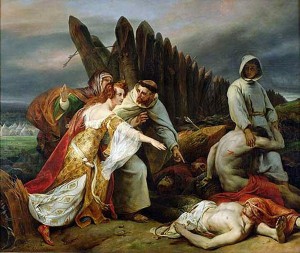Harold’s long relationship with his handfasted wife Edith Swanneck produced five or six children. Godwine, the eldest, was named after Harold’s father. Then we have Edmund (named after Edmund Ironside?), Magnus, Gunhild and Gytha. The youngest son, Ulf, was probably from this marriage, but some historians think he was the twin brother of Harold from his father’s second marriage to Ealdgyth, sister of Edwin and Morcar and (uncrowned) Queen of England.
From the first, we don’t know what happened to Edith Swanneck. Legend has it that she was brought to the battlefield to identify King Harold’s mangled corpse, based on marks that only she would know. After that, she presumably accompanied the body to Waltham Abbey for burial, but we know nothing further after that. Where were the children all this time?
We know that Gunhild took refuge in Wilton Abbey, a favorite establishment of her aunt Editha (Edward the Confessor’s wife). Perhaps Gunhild was already settled at the Abbey for her education and thus remained there after the battle. Years later, she left the Abbey in the company of Count Alain le Roux, Lord of Richmond, who was the recipient of many estates belonging to her mother. It seems that she had little vocation for the veil and took advantage of an opportunity to go back to her own lands. She and Alain lived together until his death, and afterwards she took up with his brother, Alain le Noir who inherited the estates. After le Noir’s death, she disappears from the records.
The three eldest sons of Edith may well have accompanied their mother to Ireland. Diarmaid of Leinster, the same King who sheltered Harold Godwineson back in 1051, is said to have welcomed Harold’s sons in their exile. It’s also possible that they went to Exeter, a stronghold of the Godwine family where their grandmother Gytha resided. Exeter became a focal point of local rebellion; King William took this threat seriously enough to lay siege to the city for 18 days in the winter of 1068. Apparently the besieged were not in agreement, for they capitulated to William while Gytha, accompanied by her allies, fled to the island of Flat Holm in the Bristol channel and stayed for many months.
The Irish King permitted the sons of Harold to recruit a fleet of mercenaries and invade England on two separate occasions; the last invasion proved a costly disaster in manpower and Magnus was probably killed. It’s possible that Gytha waited until it was clear that her grandsons’ cause was hopeless before leaving Flat Holme for good and traveling to Flanders. She may have entered a convent at St. Omer. Or she might have gone back to Scandinavia, where the presiding King of Denmark was her nephew.
It was thought that Godwine and Edmund probably went to Scandinavia as well, along with their sister Gytha. If they thought King Swegn would help militarily, they were destined to be disappointed. Our knowledge of their fate disappears after this, but Swegn was able to use his influence to set young Gytha up in a royal marriage. Her new husband, Vladimir Monomakh, prince of Smolensk was said to be handsome and rich, and she lived, in apparent contentment, until 1107.
Ulf, surprisingly, ended up a hostage in William the Conqueror’s court. Whether he was captured after the Exeter siege (which would make him a son of Edith Swanneck) or captured as a baby in Chester (which would make him a son of Ealdgyth) is unknown. He stayed in captivity until King William’s death in 1087, when he was released into the custody of Duke Robert, who knighted him and set him free. By all indications Ulf wisely stayed on the continent and has been identified as Loup Fitz Heraut (Wulf son of Harold) whose signature has been found in charters.
This leaves us with young Harold Haroldson, son of Queen Ealdgyth and heir to the throne if all had gone differently. Ealdgyth was heavily pregnant by the battle of Hastings, and afterwards her brothers Edwin and Morcar whisked her off to Chester for safekeeping. It is thought that the child’s uncles might have had it in mind to use him as a figurehead in a future bid for the throne, but they never got that far. When Ealdgyth found herself with no defenders, she is said to have fled to Ireland with her son. After he grew up, Harold apparently found his way to Norway. In 1098 he accompanied King Magnus III Barelegs on an expedition to Ireland, but all traces are lost after this point.
It is ironic that Godwine and his clan, once the most powerful force in England, should be reduced to historical footnotes in two generations. And it’s even more ironic that through his daughter Gytha and her son (Mstislav I Vladimirovich the Great), Harold’s blood still flows through the royal houses of Europe all the way to the present day.
(photo: Edith Swanneck discovering King Harold’s corpse on the battle field of Hastings by Horace Vernet)

No comments:
Post a Comment